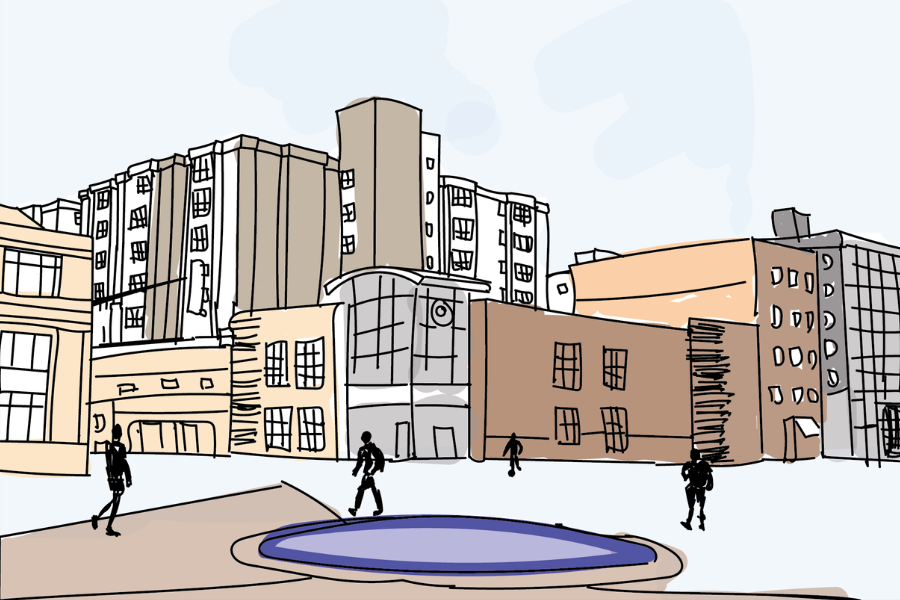With 11% of students at the University reporting biking as their primary mode of transportation on campus, bike safety and accident prevention are at the forefront of the community’s mind.
The number of bike-related accidents at the University has increased in the last few years. Speculation about the emergence of motorized bikes, increased student enrollment and lack of necessary infrastructure have circulated campus. However, the issue may be more complex.
“There are more conflicts between pedestrians and bicyclists now that there are so many e-bikes and e-scooters and e-skateboards that are out there,” said Sarthak Prasad, sustainable transportation assistant at Facilities and Services.
These electric bikes, scooters and skateboards are included in “Personal Micromobility Devices” and are subject to campus administrative policy. However, with the advent of electric bicycles, more students are willing to bike on campus, and the possibility of accidents increases.
While these motorized devices are restricted to the streets, on-street bike paths are shared lanes between nonmotorized transportation devices and motorized transportation devices. In essence, this creates a similar problem between vehicles and cyclists.
Get The Daily Illini in your inbox!
There are also no restrictions on using nonmotorized bicycles on sidewalks on campus, according to Facilities and Services, which puts pedestrians and cyclists at higher risk of collision.
A common suggestion among campus planners and transportation specialists for why bike-related incidents may be increasing is the lack of education surrounding road safety, particularly for nonfaculty community members.
“We do not provide any bike education to young people as they grow up in this country, so a lot of them have no idea how to bicycle safely,” said Cynthia Hoyle, adjunct lecturer in Urban and Regional Planning.
While there are many ways to get educated about bike safety for Champaign-Urbana community members, including through the University and the state, mandatory classes for cyclists are not in place.
Resources like the Ride Illinois BikeSafetyQuiz provide crucial information on how to stay safe on the road for all types of transportation methods, including cycling, truck driving and normal vehicles.
“Other than promoting the BikeSafetyQuiz, we’ve got some events that we host on campus,” Prasad said. “For instance, in September, we hosted the Light the Night event, where we installed bike lights to any bicycle and every bicycle. If you’re riding your bicycle in the dark, you need to have your lights on.”
Infrastructure also plays an important role in keeping cyclists, pedestrians and motorists safe. The University is considered a bike-friendly university, one of the components of which is having modern and accessible infrastructure.
One success story from the University was lowering the speed limit in the University District to 25 mph in 2002.
Increases in motor vehicle speed play a significant role in the chance of a fatality occurring in an accident, with the possibility of fatality exponentially increasing with speed.
“That’s why, mostly, the speeds on campus are much lower than they are in other places in town,” Hoyle said. “I personally would love to see automated speed enforcement. Speed is the number one factor in fatal crashes.”
However, there is still work to be done on campus bike infrastructure that is subject to funding limitations.
“We do have good infrastructure,” Prasad said. “Yes, there are areas on campus that need maintenance, that need repairs, but of course, we do have a funding constraint.”
For instance, Facilities and Services receives only $1 per student per semester toward bike infrastructure and planning.
Large-scale projects to improve roadways are not only costly but time-consuming. These projects require funding for both materials and building the new infrastructure.
Another bike safety issue that presents itself is how accidents are reported. Campus police include five types of traffic accidents in their crime statistics, all of which must meet specific criteria to be included: total crashes, accidents with injuries, accidents involving pedestrians, hit-and-run crashes and DUI crashes.
In Illinois, crashes that do not result in bodily injury or property damage over $1,500 are not required to be reported, leaving numerous incidents potentially going unreported.
“So, that’s a problem,” Hoyle said. “If we had better data on where these other crashes were occurring, we could spot that and start trying to address it, but we only get the data for property damage of $2,000 or more or injury.”
Students and community members concerned about bike and pedestrian safety can reach out to Facilities and Services with feedback and suggestions. Additionally, there’s a campus bicycle feedback form open for suggestions. Cyclists can register their bikes on campus to keep in touch with Facilities and Services and get educated on bike safety.
“Just act defensively,” Prasad said. “Make sure when you’re walking, look both ways before you cross the street … Be aware of your surroundings when you’re walking or biking. When you’re biking, have something that’s reflective on you, make sure that you’re visible to cars.”









